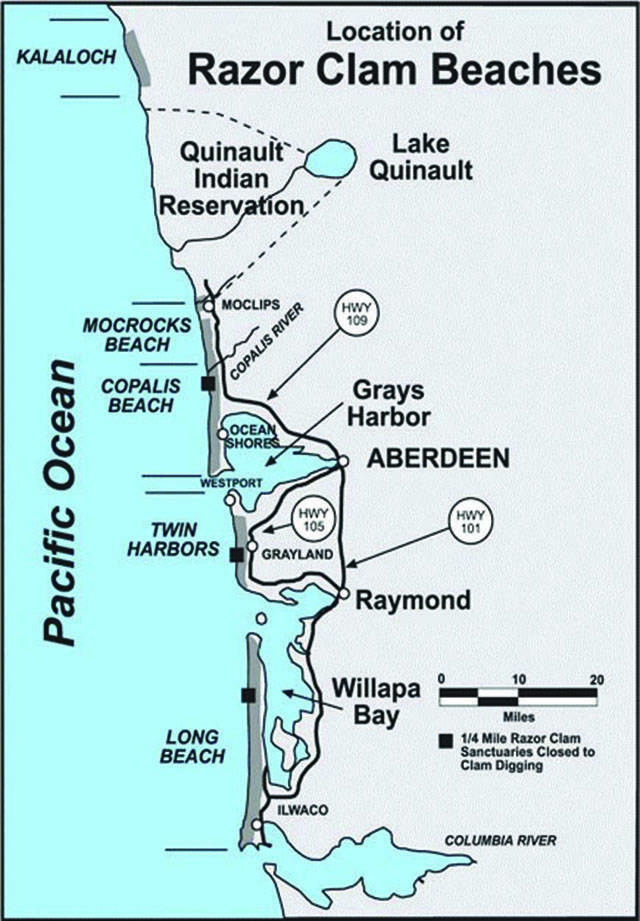A full week of afternoon and evening razor clam digs starting Feb. 15 has been approved by the State Department of Fish and Wildlife, including three days at Kalaloch and a dig at Long Beach Feb. 17.
The upcoming dig is approved on the following beaches, dates, and evening low tides:
• Feb. 15, Friday; 3:11 p.m.; 0.4 feet; Twin Harbors, Mocrocks
• Feb. 16, Saturday; 4:08 p.m.; -0.3 feet; Twin Harbors, Copalis, Kalaloch
• Feb. 17, Sunday; 4:59 p.m.; -1.0 feet; Long Beach, Twin Harbors, Copalis, Mocrocks, Kalaloch
• Feb. 18, Monday; 5:46 p.m.; -1.4 feet; Twin Harbors, Mocrocks, Kalaloch
• Feb. 19, Tuesday; 6:31 p.m.; -1.5 feet; Twin Harbors
• Feb. 20, Wednesday; 7:14 p.m.; -1.3 feet; Twin Harbors
• Feb. 21, Thursday; 7:56 p.m.; -0.8 feet; Twin Harbors
The digs were approved by the Department of Health after marine toxin tests on samples collected Feb. 5 and tested on Feb. 8 showed the clams were safe to eat.
Copalis Beach extends from the Grays Harbor north jetty to the Copalis River, and includes Ocean Shores, Oyhut, Ocean City and Copalis areas.
Mocrocks Beach is located between the Copalis River and the southern boundary of the Quinault Indian Nation (just south of the Moclips River) and includes Iron Springs, Roosevelt Beach, Seabrook, Pacific Beach, and Moclips.
Kalaloch is in Olympic National Park to the north, and is open for the first time this season.
Dan Ayres, WDFW coastal shellfish manager, recommends that diggers hit the beach about an hour or two before low tide for the best results.
“Razor clams are fun to gather and great to eat, and the seven-day schedule should provide opportunities for diggers to find a time to gather their clams for late winter get-togethers with friends and family,” said Ayres.
In order to ensure conservation of clams for future generations, WDFW sets tentative razor clam seasons that are based on the results from the annual coast-wide razor clam stock assessment and by considering harvest to date. WDFW authorizes each dig independently after getting the results of marine toxin testing.
All diggers age 15 or older must have an applicable 2018-19 fishing license to harvest razor clams on any beach. Licenses, ranging from a three-day razor clam license (starting at $9.70) to an annual combination fishing license, are available on WDFW’s website at https://fishhunt.dfw.wa.gov and from license vendors around the state.
Under state law, diggers at open beaches can take 15 razor clams per day and are required to keep the first 15 they dig. Each digger’s clams must be kept in a separate container.
The Washington Department of Fish and Wildlife is the primary state agency tasked with preserving, protecting and perpetuating fish and wildlife and ecosystems, while providing sustainable fishing and hunting opportunities. WDFW razor clam digs support outdoor lifestyles and coastal economies.
Twin Harbors Beach extends from Cape Shoalwater to the south jetty at the mouth of Grays Harbor.



